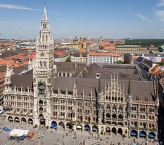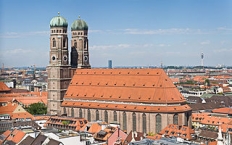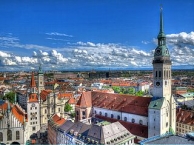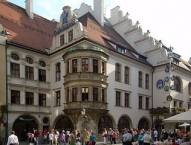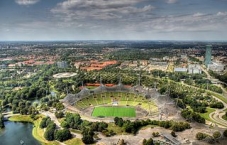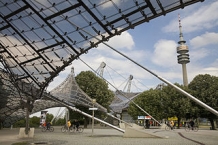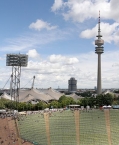Cycle Tour Munich - Regensburg - Prag
Travel report
Actions
![]()
Please wait - map data are loading
Added on 07 Oct 2016,
last edited by ihmuc on 06 Nov 2016
Actions
Cycle route metrics
planned
ridden
Total distance in km
460
447
Cumulative elevation gain in m
4.528
3.281
Avg. slope uphill in %
0,98
0,73
Cumulative elevation loss in m
4.851
3.288
Information about rights to the gps-track data | |
|---|---|
Rights owner | ihmuc & biroto-Contributors |
Rights characteristic / license | cc0: Public Domain no Rights reserved |
Link to the description of the license | |
GPX file taken from | |
GPX file uploaded | by ihmuc on 07 Oct 2016
|
Track points in total
6.316
2.334
Track points per km (avg)
14
5
Start/endpoint
Start location
München, Bayern, DE (525 m NHN)
End location
Prague, Prague, CZ (202 m NHN)
Character
wunderbare, einfache Tour; zumeist entlang von Flussläufen (auf- oder abwärts) (Isar, Abens, Donau, Regen, ..., Moldau); wenige, manchmal steilere Anstiege; fast nur auf Nebenstraßen bzw. Wegen; als Gesamtweg nicht durchgängig ausgeschildert, aber mit GPS gut zu finden; Streckenabschnitte auf stärker befahrenen Straßen unangenehm (z.B. fahren die Menschen in Tschechien überhaupt sehr flott und wenig rücksichtsvoll ggüber Radfahrern);
Information about copyright | |
|---|---|
Rights characteristic / license | by-sa: CREATIVE COMMONS Attribution-ShareAlike |
Link to the description of the license | |
taken over / edited on | 07 Oct 2016
|
taken over / edited by |
|
Landscape
Flussauen, weite Hügellandschaften mit unterschiedlichem Anbau (vom Hopfen und Mais in der Hallertau bis Getreide in Tschechien ..); schöne Wälder (zumeist Laubwald, aber auch z.B. im Bayerischen Wald/Böhmer Wald, Nadelbäume); primär ländliche Gebiete; ach ja: in Tschechien wunderbare Apfelbaumalleen :-)
Information about copyright | |
|---|---|
Rights characteristic / license | by-sa: CREATIVE COMMONS Attribution-ShareAlike |
Link to the description of the license | |
taken over / edited on | 07 Oct 2016
|
taken over / edited by |
|
Travel to and from ...
Der Start in München ist für uns einfach - hier sind wir zu Hause (man kann jedoch auch nach München z.B. gut mit dem Zug gelangen);
Die Rückfahrt von Prag erfolgte mit dem Zug - eine Direktverbindung Prag-München gibt es 4 Mal am Tag mit dem Alex (leider sehr alter, ungepflegter Zug gewesen - und Aufregung, weil im Grenzgebiet Wagen abgehängt wurden und die Anweisungen nicht klar waren - zuerst nur die Räder umstellen, dann noch das ganze Gepäck (trotz Platzkarte für das Abteil!); Radreservierung gibt es nicht!, wenn also Hochbetrieb, dann muss man sich sputen (gibt aber in jedem Abteil mind 3 Stellplätze (eBikes passen wohl weniger hin, da diese in der Regel größer ausfallen));
Connecting cycle path
diverse ...
Stages
Information about copyright | |
|---|---|
Rights owner | |
Rights characteristic / license | by-sa: CREATIVE COMMONS Attribution-ShareAlike |
Link to the description of the license | |
Image has been uploaded | by ihmuc on 31 Oct 2016
|
84 km
München - Freising - Mainburg
Beds4Cyclists, worth visiting and infrastructure
Name and address
Latitude / Longitude
Phone
Fax
Mobile
Type of accommodation
Rating for cyclists
Route km
Dist. to route
Elevation
0 km
3,2 km
543 m
0 km
1,7 km
530 m
0 km
0,0 km
527 m
Information about copyright | |
|---|---|
Rights owner | |
Rights characteristic / license | by-sa: CREATIVE COMMONS Attribution-ShareAlike |
Link to the description of the license | |
Image taken over from | |
Image has been uploaded | by biroto-Redaktion on 09 Jan 2013
|
Information about copyright | |
|---|---|
Rights owner | |
Rights characteristic / license | by-sa: CREATIVE COMMONS Attribution-ShareAlike |
Link to the description of the license | |
Image taken over from | commons.wikimedia.org/wiki/File:Frauenkirche_Munich_-_View_from_Peterskirche_Tower.jpg |
Image has been uploaded | by biroto-Redaktion on 09 Jan 2013
|
Information about copyright | |
|---|---|
Rights owner | |
Rights characteristic / license | by-sa: CREATIVE COMMONS Attribution-ShareAlike |
Link to the description of the license | |
Image taken over from | commons.wikimedia.org/wiki/File:Altes_Rathaus,_Talburgtor,_Heilig_Geist_Kirche,_Alter_Peter.jpg |
Image has been uploaded | by biroto-Redaktion on 09 Jan 2013
|
Information about copyright | |
|---|---|
Rights owner | |
Rights characteristic / license | by-sa: CREATIVE COMMONS Attribution-ShareAlike |
Link to the description of the license | |
Image taken over from | |
Image has been uploaded | by biroto-Redaktion on 09 Jan 2013
|
Munich-Altstadt
New City Hall and its Glockenspiel, Munich's Frauenkirche cathedral, the Hofbräuhaus, to name only a few—most of Munich ![]() 's must-see sights are in the city's very centre, the so-called Altstadt (Old City). The area within the old city wall (today best defined by the Altstadtring circular road), which is best visible at Odeonsplatz and the historic city gates, Karlstor, Isartor and Sendlinger Tor, has its centre at Marienplatz. This is Munich's core, from where it grew from a village to what it is today: a pedestrian zone, shopping paradise, and the main tourist hangout. The Lehel area, between Isartor and the river Isar and Munich's oldest original suburb, is often considered to be part of the city centre too. The whole area roughly is bounded by the river Isar to the east, Tivolistraße and Prinzregentenstraße to the north, and the Altstadtring circular road and Zweibrückenstraße to the west and south.
's must-see sights are in the city's very centre, the so-called Altstadt (Old City). The area within the old city wall (today best defined by the Altstadtring circular road), which is best visible at Odeonsplatz and the historic city gates, Karlstor, Isartor and Sendlinger Tor, has its centre at Marienplatz. This is Munich's core, from where it grew from a village to what it is today: a pedestrian zone, shopping paradise, and the main tourist hangout. The Lehel area, between Isartor and the river Isar and Munich's oldest original suburb, is often considered to be part of the city centre too. The whole area roughly is bounded by the river Isar to the east, Tivolistraße and Prinzregentenstraße to the north, and the Altstadtring circular road and Zweibrückenstraße to the west and south.
See
- ⊙Altes Rathaus. Built in 1474 and rebuilt after World War II to its original state. Today it houses a toy museum (Spielzeugmuseum). Outside you will find a statue of Juliet (Romeo's Juliet), a present from Munich's sister city, Verona.
- ⊙Feldherrenhalle (Field Marshal's Hall). At Odeonsplatz. Built between 1841 and 1844 by Friedrich von Gärtner at the behest of King Ludwig I of Bavaria after the example of the Loggia dei Lanzi in Florence. The Feldherrnhalle was a symbol of the honours of the Bavarian Army.
- ⊙Mariensäule. A golden statue in the middle of Marienplatz. The statue was built in honor of the Virgin Mary to celebrate the sparing of the city from the Swedes.
- ⊙Neues Rathaus/Glockenspiel. During the summer, a curious sight appears every morning in Marienplatz. Hundreds of tourists begin craning their necks skyward to see the Glockenspiel work its magic on the front facade of the Neues Rathaus (New City Hall). As the automated clockwork figures come out to dance, the bells play and the tourists gape. The Glockenspiel is truly a piece of art, it was built of handmade parts long before automation was the buzzword of the day, and it's still entrancing. There is also a view point in one of its towers.
- ⊙Hofgarten. The ,Hofgarten" (courtyard garden) is located just north of the Residenz building, at Odeonsplatz. This is a splendid royal garden, inspired by Versailles, with a nice pavillion in the middle, where tango dancers gather each Thursday. Along the sides of the Hofgarten, there are paintings of important events in Bavarian history in a chronical order. So you can stroll along those and find out more. The Hofgarten is built completly geometrical. There is also a café inside the Hofgarten, which is a really nice background to drink a coffee in. As the Hofgarten and the English Garden are connected by a pedestrian tunnel, you can easily continue to walk/bike to the English Garden from here.
Churches
- ⊙Asamkirche. Rococo architect and sculptor Egid Quirin Asam built this amazingly ornate church right next door to his own house. His brother, Cosmas Damian, did all the frescoes. The church is dedicated to St John Nepomuk, a Bohemian monk. The Asamkirche, completed in 1746, glitters like a row of diamonds and is best seen by candlelight, especially at the yearly Christmas Eve service, replete with Bavarian singers in the choir stall.
- ⊙Frauenkirche (Church of Our Lady). The Frauenkirche is topped by two copper onion-domed towers recognizable from a distance. The apparent difference in height between the two towers is not an optical illusion: the north tower is 12 centimetres taller than the south tower. The Frauenkirche differs from all contemporary churches in its plain brick simplicity, instead of having sculptural ornamentation in carved stone to the exterior like many other Gothic churches. The church was completed in 1488. The legendary Teufelstritt, or devil's footstep, stems from the large amount of light inside the Frauenkirche that seems to come from nowhere thanks to the large columns that block the view of the windows. According to legend, Jörg of Halspach made a deal with the devil that he could build a church that had a spot where not a single window could be seen from. From the vestibule, looking down the center aisle (as long as the high Baroque altar covered the windows at the very back of the church) there appeared to be no windows at all. The devil stamped his foot in a fit of pique, leaving his "footprint" on a paving stone immediately inside the entrance. Another version tells that this is where the devil stood when he curiously regarded and ridiculed the windowless church that Halsbach had built. In fact, it is a large casting in the square base plate, and none of the side windows can be seen from the spot when one looks to the high altar.The stone is readily visible because it is mustard yellow rather than red and grey like the other tiles. Right to the entrance is a monumental tomb of Emperor Ludwig IV of Bavaria, the work of Hans Krumpper.
- ⊙Michaelskirche. The largest Renaissance church north of the Alps was built between 1583-1599 thanks to Duke Wilhelm V, called The Pious. Despite nearly bankrupting Bavaria, Munich was left with an amazingly beautiful structure that houses an extremely unified iconographic program. "Iconographic program" is just an art term for the overall organized progression of religious images that corresponds to a theme. In the church crypt are the tombs of many members of Wittelsbach dynasty, including that of the "mad king" Ludwig II.
- ⊙Peterskirche (Alter Peter). Munich's first parish church was started in the twelfth century, but ongoing additions and renovations have kept artists busy for centuries. During a city fire in 1327, the church was damaged and in 1607, the tower (called Alter Peter) was struck by lightning. The side altars, which have already been renovated, are accessible, as is the immense, multi-columned gilded marble main altar. At the back of the church is a Lourdes grotto tucked under the choir loft stairs, as well as an educational display which shows step by step how a fresco is made (paint is applied to wet plasterwork, which dries as an integrated unit of base and color). Climb up the 306 steps inside the tower to have a nice view over the city center. €2,00/€1,00 for the tower climb.
- ⊙Theatinerkirche (North of city center on Odeonsplatz). The church is beautifully ornate and is probably the most eye-catching building in town, because its architecture departs dramatically from the rest of Munich's buildings. The church was built as a thanks to God for the birth of Maximilian II Emanuel, the son of Wittelsbach ruler, Ferdinand Maria.
Museums and galleries
- ⊙Bayerisches Nationalmuseum (Bavarian National Museum). One of the most important cultural history museums in Europe, housing a large collection of European artifacts from the Middle Ages until early 20th century. There's a wide range of important antiques here, from medieval armor to pottery, from furniture to porcelain, and seasonally displaying the world's largest collection of nativity scene sets.
- ⊙Jüdisches Museum (Jewish Museum), St.-Jakobs-Platz 16, ☎ +49 89 23396096. Tu-Su 10:00-18:00. Adult: €6; Reduced: €3. (updated Sep 2016)
- ⊙Münchner Stadtmuseum (Munich City Museum), St.-Jakobs-Platz 1, ☎ +49 89 23322370. Tu-Su 10:00-18:00. Apart from the permanent exhibitions Typically Munich! and National Socialism in Munich - Codes of Remembrance, the Münchner Stadtmuseum presents exhibitions on contemporary and civil history, photography, musical instruments and puppetry/fairground amusement. Permanent exhibitions: €4/€2; Special exhibitions: €6/€3.
- ⊙ National Socialism in Munich - Codes of Remembrance - Exhibits pertaining to the emergence, development, and consequences of National Socialism in Munich from 1918 – 1945. Munich as the point of origin and headquarters of the NSDAP, ‘Capital of the Movement’ and ‘Capital of German Art’: a documentation of contributors, supporters, resistance and victims.
- ⊙Residenz, Residenzstraße 1, ☎ +49 89 29067 1. Apr-15 Oct: 09:00-18:00 daily; 16 Oct-Mar: 10:00-16:00 daily. The Schatzkammer (Treasury) within the Residenz has one of the best collections of ecclesiastical treasures in Europe, not to mention the royal insignia of Bavaria (crowns, orb, scepter, etc.). The Antiquarium has the largest Renaissance room north of the Alps, and the Ahnengalerie (Ancestral Portrait Gallery) has a Wittelsbach family portrait collection. There is also a series of Rococo rooms by Cuvilliés. Combined admission for treasury and museum: Adults: €9, Reduced: €8.
- Residenz Museum, Residenzstraße 1, ☎ +49 89 29067 1. Apr-15 Oct: 09:00-18:00 daily; 16 Oct-Mar: 10:00-16:00 daily. Step in to the life of royalty in this museum dedicated to showing off the furniture and housewares of the royal family of many generations ago. Adults: €6, Reduced: €5.
- Schatzkammer (Treasury), Residenzstraße 1, ☎ +49 89 29067 1. Apr-15 Oct: 09:00-18:00 daily; 16 Oct-Mar: 10:00-16:00 daily. The crown jewels, golden works of art and much more. Adults: €6, Reduced: €5.
Buy
- ⊙Viktualienmarkt. This large open-air market sells everything from soup to nuts. Just off Marienplatz, here generations of market families continue to hawk their wares from the same location. There are open-air fruit and vegetable stands similar to those scattered around the city, as well as closed stands and little year-round trinket shops. Early in the morning and late in the afternoon on the way to and from work, locals stop by the market to pick up something from dinner. At midday it's a bit slower and therefore better for browsing.
- ⊙Schrannenhalle, Viktualienmarkt 15 (Just past the outdoor stalls of the Viktualienmarkt), ☎ +49 89 4522846 10. Officially, 10:00-20:00 every day but Sunday, when it is closed; however, many stands are open till 22:00. As this structure is just beyond the stalls of the Viktualienmarkt, the two can be easily visited in the same trip. It is open later than the stalls, which close between 18:00 and 20:00, at least in winter.
Eat
Budget
- ⊙Viktualienmarkt. On Viktualienmarkt you will find everything you need to eat. Take a Leberkaessemmel (€1.50) at one of the butcher shops or a huge bowl of soup at Münchner Suppenküche (€3-5). After getting your lunch together have a seat at the beer garden, where you can have a beer with your food. (You can bring your own food to the beer garden too.)
Mid-range
- ⊙Am Marienplatz, Marienplatz 22, ☎ +49 89 23886696. Claims to be the birthplace of Munich Weißwurst in 1857. Excellent food, extremely friendly staff, and a very clean place. Good beer, especially Weißbier, in copious amounts. Just drop in hungry, and you will leave almost bloated! €8.
- ⊙Bratwurst Glöckl (Bavarian), Frauenplatz 9 ☎ +49 89 2919450. M-Sa 10:00-01:00, Su 10:00-23:00. An authentic restaurant with a good variety of sausages, including original Nürnberger Rostbratwürstl. Great place to sit and relax outside. €5.80-22.50.
- ⊙Bräustüberl (Bavarian), Am Platzl 9, ☎ +49 89 29013610. Daily 09:00-23:30. The Bräustüberl restaurant is on the first floor of the Hofbräuhaus. Both the ambience and food are traditional Bavarian. There is live music most evenings. Reservations are recommended during high season and major festivals. €3.50-12.90.
- ⊙Haxnbauer im Scholastikahaus (Bavarian), Sparkassenstraße 6, ☎ +49 89 2166540. Daily 11:00-24:00. Haxnbauer is a restaurant where you can taste Schweinhaxe. While ordering the waiter brings several knuckles with prices on them so that you could choose which you like best. €9.50-22.
- ⊙Paulaner im Tal (Bavarian), Tal 12, ☎ +49 89 2199400. Daily 10:00-24:00. Great Bavarian food in a cosy atmosphere. €4.20-18.80.
- ⊙Weißes Bräuhaus (Bavarian), Tal 7, ☎ +49 89 2901380. Daily 08:00-01:00. Very rustic ambience. Maybe the only typical Bavarian restaurant left in the city center. Leave Marienplatz on the east. The street is called Tal. Walk 100 m, Weißes Bräuhaus is on your left hand side. €4-23.
Information about copyright | |
|---|---|
Rights characteristic / license | by-sa: CREATIVE COMMONS Attribution-ShareAlike |
Link to the description of the license | |
Input taken over from: |
Wikivoyage contributors, 'Munich/Altstadt', Wikivoyage, The FREE worldwide travel guide that anyone can edit, 11 September 2016, 16:00 UTC, <https://en.wikivoyage.org/w/index.php?title=Munich/Altstadt&oldid=3048973> [accessed 13 October 2016] |
taken over / edited on | 13 Oct 2016
|
taken over / edited by |
|
0 km
0,0 km
528 m
Hours of opening
Mo-Fr 09:30-19:30, Sa 09:00-16:00, So+Feiertage 10-00-14:00
0 km
4,5 km
509 m
Information about copyright | |
|---|---|
Rights owner | Lukáš Hron |
Rights characteristic / license | by-sa: CREATIVE COMMONS Attribution-ShareAlike |
Link to the description of the license | |
Image taken over from | |
Image has been uploaded | by Ottocolor on 20 Mar 2013
|
Information about copyright | |
|---|---|
Rights owner | Philipp Junger |
Rights characteristic / license | by-sa: CREATIVE COMMONS Attribution-ShareAlike |
Link to the description of the license | |
Image taken over from | |
Image has been uploaded | by Ottocolor on 20 Mar 2013
|
Information about copyright | |
|---|---|
Rights owner | Jorge Royan |
Rights characteristic / license | by-sa: CREATIVE COMMONS Attribution-ShareAlike |
Link to the description of the license | |
Image taken over from | commons.wikimedia.org/wiki/File:Munich_-_Frei_Otto_Tensed_structures_-_5406.jpg |
Image has been uploaded | by Ottocolor on 20 Mar 2013
|
Information about copyright | |
|---|---|
Rights owner | Henning Schlottmann |
Rights characteristic / license | by-sa: CREATIVE COMMONS Attribution-ShareAlike |
Link to the description of the license | |
Image taken over from | commons.wikimedia.org/wiki/File:Olympic_parc_Munich_0617.JPG |
Image has been uploaded | by Ottocolor on 20 Mar 2013
|
The Olympiapark in Munich , Germany, is an Olympic Park
which was constructed for the 1972 Summer Olympics
. Found in the area of Munich known as the "Oberwiesenfeld" ("upper meadow-field"), the Park continues to serve as a venue for cultural, social, and religious events such as events of worship. The Park is administered by Olympiapark München GmbH, a holding company fully owned by the state capital of Munich.
The use of the term Olympiapark to designate the overall area has prevailed as a semiofficial practice, but no official name for the entire area exists: Rather, the general area comprises four separate sub-areas:
- Olympic Area: Includes the Olympic sports facilities such as the Olympic Stadium
and the Olympic Hall
with Olympic Tower
. Also in this area are the Olympic Swim Hall
and Olympic Event Hall.
- Olympic Village
, comprising two villages, one male and one female.
- Olympic Media City ("Pressestadt"), today the home of the Olympic Shopping Center. Strictly speaking, this portion belongs to the area of district of "Moosach."
- Olympic Park: Adjoining the Olympic Area to the south, this park includes the Olympic Mountain and Olympic Lake.
Information about copyright | |
|---|---|
Rights characteristic / license | by-sa: CREATIVE COMMONS Attribution-ShareAlike |
Link to the description of the license | |
Input taken over from: |
Olympiapark, Munich. (2013, March 19). In Wikipedia, The Free Encyclopedia. Retrieved 15:29, March 20, 2013, from http://en.wikipedia.org/w/index.php?title=Olympiapark,_Munich&oldid=545339022 |
taken over / edited on | 20 Mar 2013
|
taken over / edited by |
|
![]()


